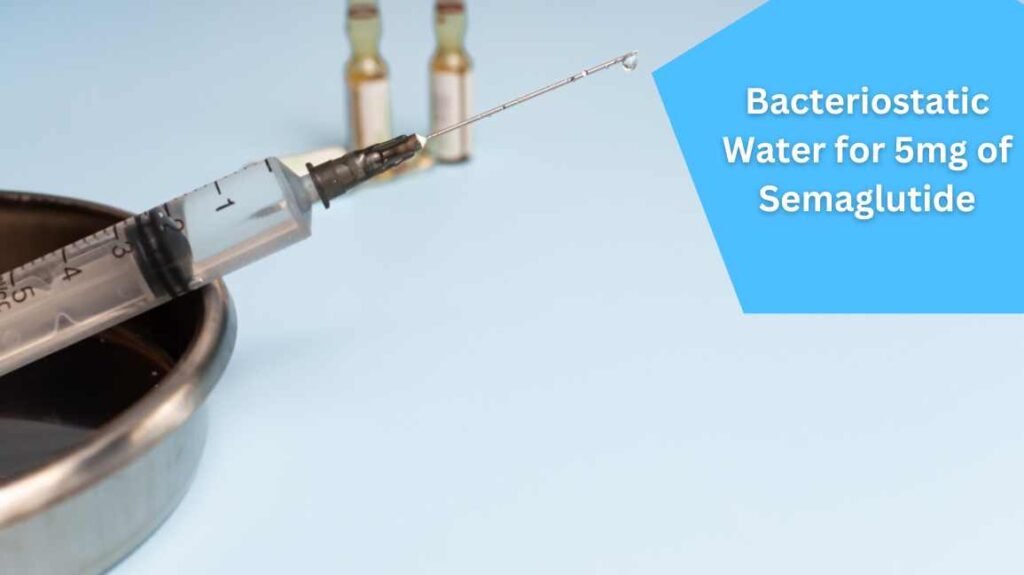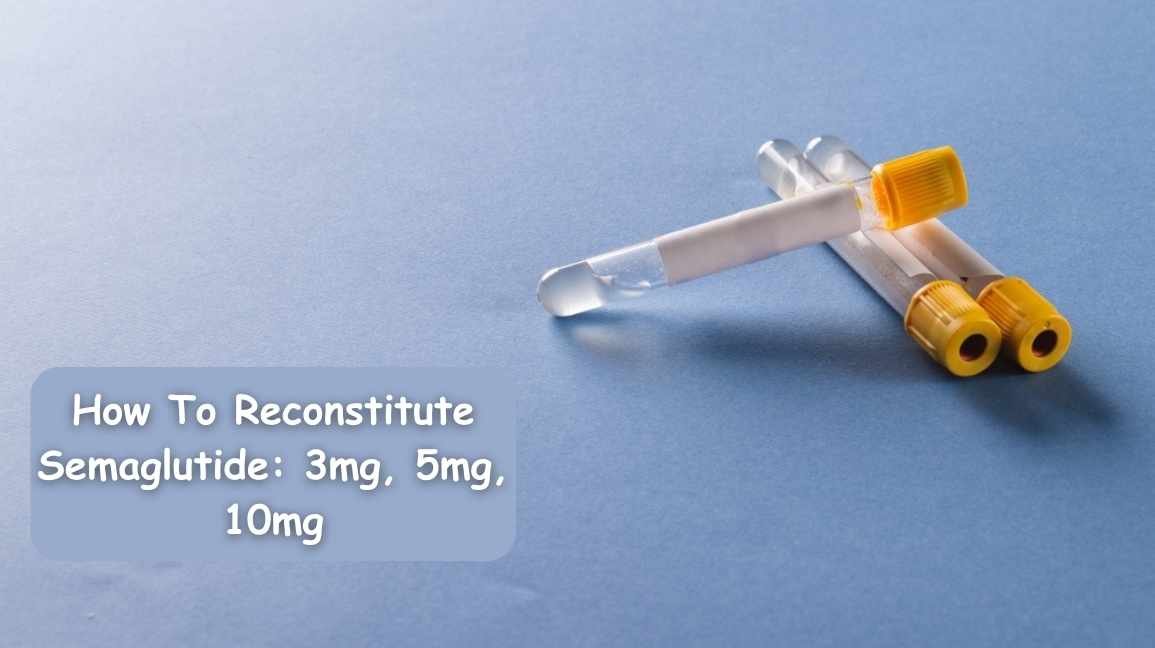Semaglutide is a powerful ally in the pursuit of better health and managing diabetes. However, properly reconstituting Semaglutide is a vital step toward its effective usage.
This article aims to provide you with the correct procedures for reconstituting different dosages of Semaglutide, ensuring you get the maximum benefit from this medication.
Whether you’re dealing with a 3mg, 5mg, or 10mg dose, we’ve got you covered. So, let’s jump right in and make the Semaglutide reconstitution process easy to understand.
Understanding Semaglutide
Semaglutide is a type of medication called GLP-1 receptor agonist, used mainly to treat type 2 diabetes. It’s also used to help patients lose weight, lower blood sugar levels, and reduce the risk of serious cardiovascular events like heart attacks or strokes.
Semaglutide works by mimicking the effects of GLP-1, a naturally occurring hormone in the body, which helps to regulate insulin levels and control blood sugar.
It has a longer half-life than natural GLP-1, which means it only needs to be taken once a week, unlike other antidiabetic medications that require daily doses.
You can get it in two forms: a pill you take by mouth or an injectable solution. The injectable solution needs to be mixed with a specific amount of fluid (usually bacteriostatic water) before use. This process turns the powdered medication into a solution that can be injected.
Also Read: How Many Mg is 40 Units of Semaglutide? Converting units to mg
A step-by-step guide to reconstitution of Semaglutide
Before you begin the process of reconstituting Semaglutide, make sure to gather all necessary supplies. You will need the
- Semaglutide vial
- a vial of bacteriostatic water
- a sterile syringe, and alcohol swabs.
Make sure your workspace is clean and disinfected. Here is a step-by-step guide to reconstitution of Semaglutide:
- Using an alcohol swab, clean the tops of both vials: the Semaglutide and the bacteriostatic water.
- First, remove the cap from the diluent vial and give the rubber membrane a quick clean using an alcohol prep pad. Then, uncap the needle of the syringe and slowly draw in air that matches the amount of diluent you’ll be using.
- Insert the needle into the bacteriostatic water vial and push out all the air into it before withdrawing an equal volume of solution from it.
- With one hand on both vials, invert them so they form a V-shape with the bacteriostatic water above the Semaglutide vial. Note that the needle should be in the medication vial.
- Fill the syringe with the recommended amount of bacteriostatic water. The specific quantity for the dose of Semaglutide will be provided in the medication instructions.
- Then slowly inject the water into the Semaglutide vial and aim the syringe needle to the side of the vial so the water gently slides down the sides.
- Once the water is added, gently swirl the vial until the powder is fully dissolved.
- Do not shake the vial as this may cause the medication to become frothy or bubbly.
- Once the Semaglutide is fully dissolved, it is ready to be drawn up into a new, sterile syringe for injection.
How to reconstitute 5 mg Semaglutide?

When reconstituting 5 mg Semaglutide, you will need to use 1.5 ml of bacteriostatic water. Follow the same steps as described earlier but make sure to measure out the exact quantity of fluid for this specific dosage.
After adding the fluid, swirl the vial gently until the medication is completely dissolved. It’s vital not to shake the vial, as this may result in a frothy or bubbly solution, which can have an impact on the effectiveness of the dose.
Remember, this preparation must be done right before the injection; once reconstituted, it cannot be stored for future use.
Also Read: How Much Bacteriostatic Water to Mix with 5mg of Semaglutide?
How much bacteriostatic water to mix with 3mg of semaglutide?
To reconstitute a 3mg dose of Semaglutide, you will need to use 1.0 ml of bacteriostatic water. As with the reconstitution of any other dosage, start by cleaning the tops of both the Semaglutide and bacteriostatic water vials with an alcohol swab.
Measure the necessary amount of bacteriostatic water with care. Inject it slowly into the Semaglutide vial, aiming the stream at the side to prevent excessive foaming.
Then, swirl the vial gently to dissolve the powder completely. Just like the 5mg dosage, it is important to avoid shaking the vial. The reconstituted solution should always be used immediately after preparation to ensure its effectiveness and cannot be stored.
How much bacteriostatic water to mix with 10mg?
When reconstituting a 10mg dose of Semaglutide, you’ll need to use 2.0 ml of bacteriostatic water. Follow the same steps in the reconstitution process as detailed above, but ensure the correct amount of fluid for this specific dosage.
The key is to add the bacteriostatic water to the vial gently, aiming the syringe needle at the vial’s side, allowing the water to slide down its sides.
However, if you need to calculate the amount of bacteriostatic water for any other concentration, use the following formula:
Concentration (mg/mL) = Total dose (mg) / Diluent volume (mL)
Who can actually take Semaglutide?
Semaglutide is a medication approved for weight loss. It’s generally safe for most adults needing help with blood sugar levels. Especially beneficial for type 2 diabetes and high cardiovascular risk. Just keep in mind that it may not be a fit for everyone.
It is also prescribed for people:
- with a body mass index (BMI) of 30kg/m2 or higher.
- with a BMI of 27kg/m2 or higher if they have at least one comorbid condition associated with overweight.
Who should avoid taking Semaglutide?
Semaglutide should be avoided by the following groups of individuals:
- People with a personal or family history of medullary thyroid carcinoma (a type of thyroid cancer) or Multiple Endocrine Neoplasia syndrome type 2 (a rare genetic disorder that can lead to cancer).
- Those with severe gastrointestinal disorders, including gastroparesis (a condition in which the stomach takes too long to empty its contents) or inflammatory bowel disease (conditions that cause chronic inflammation of the digestive tract).
- Pregnant women, unless the potential benefit outweighs the potential risk.
- Breastfeeding women should only proceed if the potential benefit outweighs the potential risk.
- People under the age of 18 as the safety and efficacy of Semaglutide in this age group have not been established.
- Individuals with known hypersensitivity to Semaglutide or any of its components.
- Patients with a history of diabetic ketoacidosis.
Conclusion
In conclusion, Semaglutide is a powerful medication used for weight loss, managing type 2 diabetes, and high cardiovascular risk. It needs to be carefully mixed with bacteriostatic water in specific volumes, depending on the dosage.
While helpful for many, some individuals, such as those with specific health conditions or those who are pregnant or breastfeeding, should be cautious.
As always, it’s important to consult with a doctor to understand if Semaglutide is the right treatment option for you. Understanding the process of reconstitution and proper use can ensure the medication’s effectiveness and safety.
FAQ
Can I mix the diluent solution with the semaglutide powder before attaching the needle?
No, you should not mix the diluent solution with the semaglutide powder before attaching the needle. The needle should be attached first, and then the diluent solution should be slowly added to the semaglutide powder. This ensures accurate dosage and prevents any possible contamination.
Do I need to refrigerate the semaglutide pen before or after reconstitution?
Semaglutide pens do not need to be refrigerated before reconstitution. After reconstitution, it’s best to keep them refrigerated between 2°C and 8°C. Avoid freezing the pen and keep it away from the cooling element in the fridge. If you need to use it right away, you can keep it at room temperature (below 30°C) for up to 56 days.
Can I reuse a semaglutide pen?
No, you should not reuse a semaglutide pen. Each pen is designed for single use only, and reusing it can lead to contamination, improper dosage, or infection.
How to reconstitute 5mg semaglutide for weight loss?
To reconstitute a 5mg semaglutide dosage for weight loss, you will need 1.5 ml of bacteriostatic water. Start by cleaning the tops of the semaglutide and bacteriostatic water vials with an alcohol swab.
Carefully measure 1.5 ml of bacteriostatic water, then slowly inject it into the semaglutide vial, making sure the water hits the vial’s side to prevent foaming. Swirl the vial gently until the powder dissolves completely, without shaking. Use this mixture right away and don’t save it for later.

Hello Friends!
My name is Ahmad, reading books and gaining knowledge about Health, skin and their conditions is my passion and I am here to share my knowledge and experience with you. I hope it’s very helpful for you.
Thank you very much.
